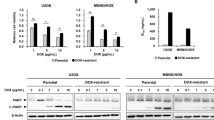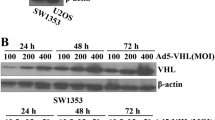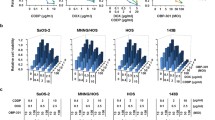Abstract
Osteosarcoma (OS) severely threatens the health of young people and understanding on the molecular mechanisms of OS etiology enables gene therapy to become an effective therapeutic modality. However, insufficient expression level of genes using existing vectors limits the clinical application of gene therapy for OS. To solve the problem, we developed an oncolytic adenoviral vector, OAT, which can selectively and efficiently replicate in OS cells to enhance the expression of transferred genes. We demonstrated that OAT-mediated TRAIL expression is significantly elevated after infection of OS cells than replication-incompetent Ad5 vector. Increased antitumor capacity was observed in OS cells after OAT-TRAIL treatment both in vitro and in vivo. In normal cells, adenoviral replication, TRAIL expression and growth-inhibiting effect were quite limited when OAT-TRAIL was administrated, showing a high biosafety of this oncolytic adenoviral vector. Collectively, we generated an efficient and promising expression vector for OS gene therapy.





Similar content being viewed by others
References
Bacci G, Briccoli A, Rocca M, Ferrari S, Donati D, Longhi A, Bertoni F, Bacchini P, Giacomini S, Forni C, Manfrini M, Galletti S (2003) Neoadjuvant chemotherapy for osteosarcoma of the extremities with metastases at presentation: recent experience at the Rizzoli Institute in 57 patients treated with cisplatin, doxorubicin, and a high dose of methotrexate and ifosfamide. Ann Oncol 14(7):1126–1134
Sluga M, Windhager R, Lang S, Heinzl H, Bielack S, Kotz R (1999) Local and systemic control after ablative and limb sparing surgery in patients with osteosarcoma. Clin Orthop Relat Res 358:120–127
Ko SC, Cheon J, Kao C, Gotoh A, Shirakawa T, Sikes RA, Karsenty G, Chung LW (1996) Osteocalcin promoter-based toxic gene therapy for the treatment of osteosarcoma in experimental models. Cancer Res 56(20):4614–4619
Cheon J, Ko SC, Gardner TA, Shirakawa T, Gotoh A, Kao C, Chung LW (1997) Chemogene therapy: osteocalcin promoter-based suicide gene therapy in combination with methotrexate in a murine osteosarcoma model. Cancer Gene Ther 4(6):359–365
Seto M, Yamazaki T, Sonoda J, Matsumine A, Shinto Y, Uchida A (2002) Suppression of tumor growth and pulmonary metastasis in murine osteosarcoma using gene therapy. Oncol Rep 9(2):337–340
Craig C, Kim M, Ohri E, Wersto R, Katayose D, Li Z, Choi YH, Mudahar B, Srivastava S, Seth P, Cowan K (1998) Effects of adenovirus-mediated p16INK4A expression on cell cycle arrest are determined by endogenous p16 and Rb status in human cancer cells. Oncogene 16(2):265–272
Hemmati PG, Gillissen B, von Haefen C, Wendt J, Starck L, Guner D, Dorken B, Daniel PT (2002) Adenovirus-mediated overexpression of p14(ARF) induces p53 and Bax-independent apoptosis. Oncogene 21(20):3149–3161
Yazawa M, Setoguchi A, Hong SH, Uyama R, Nakagawa T, Kanaya N, Nishimura R, Sasaki N, Masuda K, Ohno K, Tsujimoto H (2003) Effect of an adenoviral vector that expresses the canine p53 gene on cell growth of canine osteosarcoma and mammary adenocarcinoma cell lines. Am J Vet Res 64(7):880–888
Maeda A, Nakamura S, Isono M, Osaki M, Ito H, Sato K (2006) Induction of efficient apoptosis and cell-cycle arrest in tumor cells by adenovirus-mediated p53 A4 mutant. Pathol Int 56(3):126–134
Kim M, Sgagias M, Deng X, Jung YJ, Rikiyama T, Lee K, Ouellette M, Cowan K (2004) Apoptosis induced by adenovirus-mediated p14ARF expression in U2OS osteosarcoma cells is associated with increased Fas expression. Biochem Biophys Res Commun 320(1):138–144
Oshima Y, Sasaki Y, Negishi H, Idogawa M, Toyota M, Yamashita T, Wada T, Nagoya S, Kawaguchi S, Yamashita T, Tokino T (2007) Antitumor effect of adenovirus-mediated p53 family gene transfer on osteosarcoma cell lines. Cancer Biol Ther 6(7):1058–1066
Picarda G, Lamoureux F, Geffroy L, Delepine P, Montier T, Laud K, Tirode F, Delattre O, Heymann D, Redini F (2010) Preclinical evidence that use of TRAIL in Ewing’s sarcoma and osteosarcoma therapy inhibits tumor growth, prevents osteolysis, and increases animal survival. Clin Cancer Res 16(8):2363–2374
Huang EY, Madireddi MT, Gopalkrishnan RV, Leszczyniecka M, Su Z, Lebedeva IV, Kang D, Jiang H, Lin JJ, Alexandre D, Chen Y, Vozhilla N, Mei MX, Christiansen KA, Sivo F, Goldstein NI, Mhashilkar AB, Chada S, Huberman E, Pestka S, Fisher PB (2001) Genomic structure, chromosomal localization and expression profile of a novel melanoma differentiation associated (mda-7) gene with cancer specific growth suppressing and apoptosis inducing properties. Oncogene 20(48):7051–7063
Kaya M, Wada T, Nagoya S, Yamashita T (2007) Prevention of postoperative progression of pulmonary metastases in osteosarcoma by antiangiogenic therapy using endostatin. J Orthop Sci 12(6):562–567
Chang B, Punj V, Shindo M, Chaudhary PM (2007) Adenoviral-mediated gene transfer of ectodysplasin-A2 results in induction of apoptosis and cell-cycle arrest in osteosarcoma cell lines. Cancer Gene Ther 14(11):927–933
Lamoureux F, Richard P, Wittrant Y, Battaglia S, Pilet P, Trichet V, Blanchard F, Gouin F, Pitard B, Heymann D, Redini F (2007) Therapeutic relevance of osteoprotegerin gene therapy in osteosarcoma: blockade of the vicious cycle between tumor cell proliferation and bone resorption. Cancer Res 67(15):7308–7318
David E, Guihard P, Brounais B, Riet A, Charrier C, Battaglia S, Gouin F, Ponsolle S, Bot RL, Richards CD, Heymann D, Redini F, Blanchard F (2011) Direct anti-cancer effect of oncostatin M on chondrosarcoma. Int J Cancer 128:1822–1835
Benjamin R, Helman L, Meyers P, Reaman G (2001) A phase I/II dose escalation and activity study of intravenous injections of OCaP1 for subjects with refractory osteosarcoma metastatic to lung. Hum Gene Ther 12(12):1591–1593
Hemminki A, Kanerva A, Kremer EJ, Bauerschmitz GJ, Smith BF, Liu B, Wang M, Desmond RA, Keriel A, Barnett B, Baker HJ, Siegal GP, Curiel DT (2003) A canine conditionally replicating adenovirus for evaluating oncolytic virotherapy in a syngeneic animal model. Mol Ther 7(2):163–173
Witlox AM, Van Beusechem VW, Molenaar B, Bras H, Schaap GR, Alemany R, Curiel DT, Pinedo HM, Wuisman PI, Gerritsen WR (2004) Conditionally replicative adenovirus with tropism expanded towards integrins inhibits osteosarcoma tumor growth in vitro and in vivo. Clin Cancer Res 10(1 Pt 1):61–67
Graat HC, van Beusechem VW, Schagen FH, Witlox MA, Kleinerman ES, Helder MN, Gerritsen WR, Kaspers GJ, Wuisman PI (2008) Intravenous administration of the conditionally replicative adenovirus Ad5-Delta24RGD induces regression of osteosarcoma lung metastases. Mol Cancer 7:9
Li X, Jung C, Liu YH, Bae KH, Zhang YP, Zhang HJ, Vanderputten D, Jeng MH, Gardner TA, Kao C (2006) Anti-tumor efficacy of a transcriptional replication-competent adenovirus, Ad-OC-E1a, for osteosarcoma pulmonary metastasis. J Gene Med 8(6):679–689
Kim NW, Piatyszek MA, Prowse KR, Harley CB, West MD, Ho PL, Coviello GM, Wright WE, Weinrich SL, Shay JW (1994) Specific association of human telomerase activity with immortal cells and cancer. Science 266(5193):2011–2015
Shay JW, Bacchetti S (1997) A survey of telomerase activity in human cancer. Eur J Cancer 33(5):787–791
Ulaner GA, Huang HY, Otero J, Zhao Z, Ben-Porat L, Satagopan JM, Gorlick R, Meyers P, Healey JH, Huvos AG, Hoffman AR, Ladanyi M (2003) Absence of a telomere maintenance mechanism as a favorable prognostic factor in patients with osteosarcoma. Cancer Res 63(8):1759–1763
Sotillo-Pineiro E, Sierrasesumaga L, Patinno-Garcia A (2004) Telomerase activity and telomere length in primary and metastatic tumors from pediatric bone cancer patients. Pediatr Res 55(2):231–235
Li G, Kawashima H, Ogose A, Ariizumi T, Xu Y, Hotta T, Urata Y, Fujiwara T, Endo N (2011) Efficient virotherapy for osteosarcoma by telomerase-specific oncolytic adenovirus. J Cancer Res Clin Oncol 137(6):1037–1051
Chou AJ, Geller DS, Gorlick R (2008) Therapy for osteosarcoma: where do we go from here? Paediatr Drugs 10(5):315–327
O’Day K, Gorlick R (2009) Novel therapeutic agents for osteosarcoma. Expert Rev Anticancer Ther 9(4):511–523
Gorlick R, Anderson P, Andrulis I, Arndt C, Beardsley GP, Bernstein M, Bridge J, Cheung NK, Dome JS, Ebb D, Gardner T, Gebhardt M, Grier H, Hansen M, Healey J, Helman L, Hock J, Houghton J, Houghton P, Huvos A, Khanna C, Kieran M, Kleinerman E, Ladanyi M, Lau C, Malkin D, Marina N, Meltzer P, Meyers P, Schofield D, Schwartz C, Smith MA, Toretsky J, Tsokos M, Wexler L, Wigginton J, Withrow S, Schoenfeldt M, Anderson B (2003) Biology of childhood osteogenic sarcoma and potential targets for therapeutic development: meeting summary. Clin Cancer Res 9(15):5442–5453
Nokisalmi P, Pesonen S, Escutenaire S, Sarkioja M, Raki M, Cerullo V, Laasonen L, Alemany R, Rojas J, Cascallo M, Guse K, Rajecki M, Kangasniemi L, Haavisto E, Karioja-Kallio A, Hannuksela P, Oksanen M, Kanerva A, Joensuu T, Ahtiainen L, Hemminki A (2010) Oncolytic adenovirus ICOVIR-7 in patients with advanced and refractory solid tumors. Clin Cancer Res 16(11):3035–3043
Koski A, Kangasniemi L, Escutenaire S, Pesonen S, Cerullo V, Diaconu I, Nokisalmi P, Raki M, Rajecki M, Guse K, Ranki T, Oksanen M, Holm SL, Haavisto E, Karioja-Kallio A, Laasonen L, Partanen K, Ugolini M, Helminen A, Karli E, Hannuksela P, Pesonen S, Joensuu T, Kanerva A, Hemminki A (2010) Treatment of cancer patients with a serotype 5/3 chimeric oncolytic adenovirus expressing GMCSF. Mol Ther 18(10):1874–1884
Rojas JJ, Guedan S, Searle PF, Martinez-Quintanilla J, Gil-Hoyos R, Alcayaga-Miranda F, Cascallo M, Alemany R (2010) Minimal RB-responsive E1A promoter modification to attain potency, selectivity, and transgene-arming capacity in oncolytic adenoviruses. Mol Ther 18(11):1960–1971
He X, Liu J, Yang C, Su C, Zhou C, Zhang Q, Li L, Wu H, Liu X, Wu M, Qian Q (2011) 5/35 fiber-modified conditionally replicative adenovirus armed with p53 shows increased tumor-suppressing capacity to breast cancer cells. Hum Gene Ther 22(3):283–292
Xiao LL, Wu YM, Qian J, Tan Y, Xie GL, Zhang KJ, Wang YG, Jia XY, Liu XY (2010) The antitumor efficacy of IL-24 mediated by E1A and E1B triple regulated oncolytic adenovirus. Cancer Biol Ther 10(3):242–250
Dirice E, Sanlioglu AD, Kahraman S, Ozturk S, Balci MK, Omer A, Griffith TS, Sanlioglu S (2009) Adenovirus-mediated TRAIL gene (Ad5hTRAIL) delivery into pancreatic islets prolongs normoglycemia in streptozotocin-induced diabetic rats. Hum Gene Ther 20(10):1177–1189
Wei RC, Cao X, Gui JH, Zhou XM, Zhong D, Yan QL, Huang WD, Qian QJ, Zhao FL, Liu XY (2011) Augmenting the antitumor effect of TRAIL by SOCS3 with double-regulated replicating oncolytic adenovirus in hepatocellular carcinoma. Hum Gene Ther 22(9):1109–1119
He Q, Shi J, Shen XL, An J, Sun H, Wang L, Hu YJ, Sun Q, Fu LC, Sheikh MS, Huang Y (2010) Dihydroartemisinin upregulates death receptor 5 expression and cooperates with TRAIL to induce apoptosis in human prostate cancer cells. Cancer Biol Ther 9(10):819–824
Jiang XL, Du LL, Yang S, Chen LS, Lu GX (2009) Suppression of teratocarcinoma growth by soluble TRAIL gene expression driven by the progression-elevated gene-3 promoter. Cancer Biol Ther 8(15):1517–1524
Zang G, Miao L, Mu Y, Qiao C, Liu J, Ke X, Zheng C, Sun H (2009) Adenoviral mediated transduction of adenoid cystic carcinoma by human TRAIL gene driven with hTERT tumor specific promoter induces apoptosis. Cancer Biol Ther 8(10):966–972
Kawashima H, Ogose A, Yoshizawa T, Kuwano R, Hotta Y, Hotta T, Hatano H, Kawashima H, Endo N (2003) Expression of the coxsackievirus and adenovirus receptor in musculoskeletal tumors and mesenchymal tissues: efficacy of adenoviral gene therapy for osteosarcoma. Cancer Sci 94(1):70–75
Witlox MA, Van Beusechem VW, Grill J, Haisma HJ, Schaap G, Bras J, Van Diest P, De Gast A, Curiel DT, Pinedo HM, Gerritsen WR, Wuisman PI (2002) Epidermal growth factor receptor targeting enhances adenoviral vector based suicide gene therapy of osteosarcoma. J Gene Med 4(5):510–516
Carette JE, Graat HC, Schagen FH, Mastenbroek DC, Rots MG, Haisma HJ, Groothuis GM, Schaap GR, Bras J, Kaspers GJ, Wuisman PI, Gerritsen WR, van Beusechem VW (2007) A conditionally replicating adenovirus with strict selectivity in killing cells expressing epidermal growth factor receptor. Virology 361(1):56–67
Luo J, Xia Q, Zhang R, Lv C, Zhang W, Wang Y, Cui Q, Liu L, Cai R, Qian C (2008) Treatment of cancer with a novel dual-targeted conditionally replicative adenovirus armed with mda-7/IL-24 gene. Clin Cancer Res 14(8):2450–2457
Alemany R, Suzuki K, Curiel DT (2000) Blood clearance rates of adenovirus type 5 in mice. J Gen Virol 81(Pt 11):2605–2609
Gao YS, Mei J, Tong TL, Hu M, Xue HM, Cai XS (2009) Inhibitory effects of VEGF-siRNA mediated by adenovirus on osteosarcoma-bearing nude mice. Cancer Biother Radiopharm 24(2):243–247
Xie XK, Yang DS, Ye ZM, Tao HM (2006) Recombinant antisense C-myc adenovirus increase in vitro sensitivity of osteosarcoma MG-63 cells to cisplatin. Cancer Invest 24(1):1–8
Ma L, Liu J, Shen J, Liu L, Wu J, Li W, Luo J, Chen Q, Qian C (2010) Expression of miR-122 mediated by adenoviral vector induces apoptosis and cell cycle arrest of cancer cells. Cancer Biol Ther 9(7):554–561
Zhao Y, Li Y, Wang Q, Wang L, Yang H, Li M (2011) Increased antitumor capability of fiber-modified adenoviral vector armed with TRAIL against bladder cancers. Mol Cell Biochem 353(1–2):93–99
Wang X, Su C, Cao H, Li K, Chen J, Jiang L, Zhang Q, Wu X, Jia X, Liu Y, Wang W, Liu X, Wu M, Qian Q (2008) A novel triple-regulated oncolytic adenovirus carrying p53 gene exerts potent antitumor efficacy on common human solid cancers. Mol Cancer Ther 7(6):1598–1603
Conflict of interest
None declared.
Author information
Authors and Affiliations
Corresponding author
Additional information
Li Chunbao and Cheng Qianpeng contributed equally to this study.
Rights and permissions
About this article
Cite this article
Chunbao, L., Qianpeng, C., Jia, L. et al. Potent growth-inhibitory effect of TRAIL therapy mediated by double-regulated oncolytic adenovirus on osteosarcoma. Mol Cell Biochem 364, 337–344 (2012). https://doi.org/10.1007/s11010-012-1235-9
Received:
Accepted:
Published:
Issue Date:
DOI: https://doi.org/10.1007/s11010-012-1235-9




